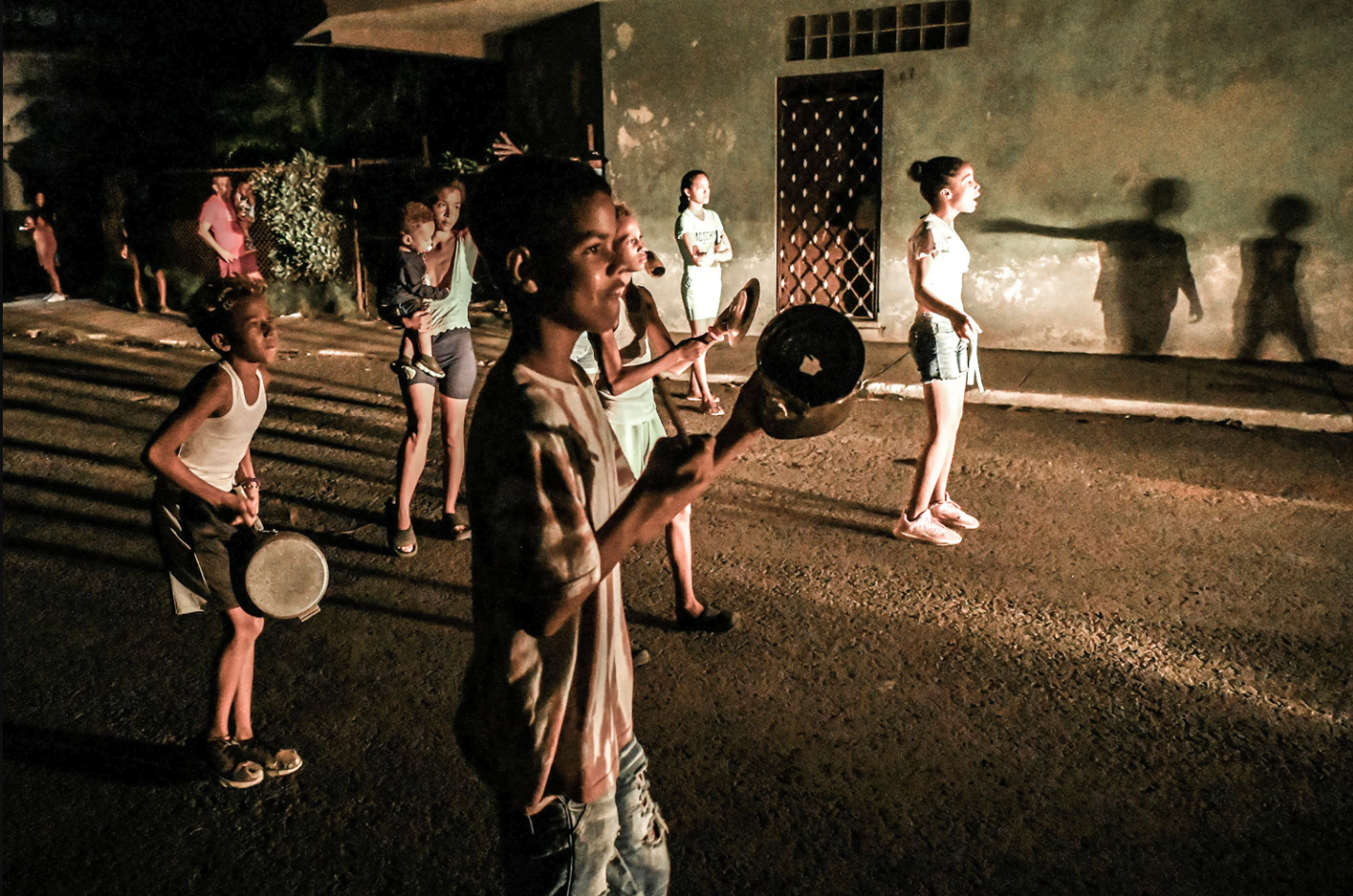Recent derogatory language from state-controlled media in Cuba, targeting protesters demanding ‘electricity, food’ and ‘freedom’ in Santiago de Cuba and elsewhere, underscores the strong link between official dehumanizing discourse and repression in the country. An article titled “No One Can Take Away Our Peace,” published on March 23, 2024, by the Sierra Maestra newspaper, branded protesters as “pitiful people” and “parasites,” inciting public “repudiation.” This intolerant rhetoric swiftly led to repression, with 19 to 41 protesters arrested in March 2024 and 374 repressive actions against activists. This pattern reflects a longstanding tradition of using official discourse to justify human rights violations in Cuba.
A clear link exists between the official discourse of intolerance, the dehumanization of perceived ‘others’, and political repression, drawing on historical events spanning over six decades. The lack of freedom to access the media and the absence of an independent judicial system further exacerbate this harmful cycle, leaving individuals defenseless against regime abuses.
Invisibilization of the Individual in the Cuban Regime’s Discourse
For over six decades, the Communist Party of Cuba and the ruling elite have denied fundamental human rights to the Cuban people. Unlike the Universal Declaration of Human Rights, which puts the individual at the epicenter of inalienable rights, the Cuban regime emphasizes state control, demanding absolute loyalty and maintaining total control. Consequently, it violates fundamental rights and renders individuals invisible.
For the architects of totalitarianism in Cuba, such as Ernesto ‘Che’ Guevara, the concept of the ‘New Man‘ or ‘New Mass Man,’ which would be the archetype of the new regime supporter, represented an individual closely integrated with the masses, devoid of independent thought and individuality. Fidel Castro, through his rhetoric demanding unconditional support for the system, famously told intellectuals and artists in 1961, “within the Revolution, everything goes; against the Revolution, nothing.” Castro also actively promoted the suppression of any dissenting voice to his regime. His statement on January 2, 1961, delivered during a speech in Civic Square, encapsulated this approach: “With the Revolution, there is no alternative: either the counterrevolution annihilates the Revolution, or the Revolution annihilates the counterrevolution.” This declaration would become the cornerstone of the suppression of dissenting ideas in Cuba for decades to come.
The Interplay of Intolerance Discourse and Repression in Cuba
In Cuba, dehumanizing language directed at individuals seen as different, based on political beliefs, religion, sexual orientation, or lifestyles, has long correlated with widespread repression. This pattern emerged as early as 1959, notably evident in the treatment of dissenting students at the University of Havana in the regime’s early years. Pejorative language, targeting individuals with dissenting views and labeled as “pepillos,” “gusanos” (worms), and “counterrevolutionaries,” was directed at young Catholics and university students who stood up in support of university autonomy and opposed state control of the institution, as well as the pro-Soviet and totalitarian transformation of the emerging regime.
In parallel with this intolerant rhetoric, the University of Havana swiftly became militarized. Beginning in October 1959, university brigades were deployed on campus to monitor dissent and suppress public demonstrations, focusing on the ‘escalinata universitaria,’ a place of strong symbolism as it was where protest marches against dictatorial regimes began during the republican era. It’s noteworthy that on February 25, 1960, university brigades, fueled by this discourse, carried out what was likely one of the regime’s earliest acts of repudiation, violently attacking students who protested the dictatorial and pro-Soviet direction of the revolution, in front of the CMQ TV Station.
During the 1960s, notably in the “Era of Construction of Socialism and Communism,” the regime pursued mass indoctrination to instill communism through agricultural work. Magazines like Mella played pivotal roles in endorsing this agenda and using homophobic language in numerous articles and caricatures, derogatorily labeling young people for their sexual identity and lifestyles.
All these publications along with speeches by Fidel Castro whose words carried a determining influence due to his absolute control of the government led to the establishment of the Military Units for Aid to Production (UMAP) in October 1965. Essentially, these were concentration camps where individuals faced reprisals based on their sexual orientation, religious beliefs, or lifestyles deviating from the ideal of the new man. Gross human rights violations occurred in these camps, denounced at the time by the global intellectual community supporting the revolution. Furthermore, during the mass roundup of September 1968 in Havana, thousands of young people were arrested solely based on their appearance and attire, then sent to agricultural re-education camps where they endured forced labor and various forms of abuse.
The ICAIC Newsreel, directed by Santiago Alvarez and screened in Cuban cinemas for three decades (1960-1990), spanning 1,493 editions, became a potent propaganda platform for disseminating dehumanizing rhetoric. Notably, the April 22,1980 newsreel titled ‘La Marcha del Pueblo Combatiente,’ employed disturbing cinematographic techniques reminiscent of Nazi propaganda. It depicted Cuban asylum seekers in the Peruvian Embassy as rats, echoing the dehumanization methods used in the Nazis‘ most virulent anti-Jewish propaganda, such as the pseudo-documentary ‘The Eternal Jew’.
Acts of Repudiation
In this context, the correlation between dehumanizing discourse and violent repression became evident and intensified through widespread acts of repudiation, public demonstrations, displays of homophobia, and public humiliations against Cubans expressing their intention to leave the country, along with verbal and physical violence. Orchestrated by the regime and carried out by Committees for the Defense of the Revolution and other repressive agencies of the Ministry of the Interior, these actions targeted hundreds of thousands of Cubans during the events at the Peruvian Embassy and the Mariel exodus in April and May 1980.
The verbal and physical violence of repudiation acts against dissidents highlight the close link between intolerant discourse and political repression. The Ladies in White, relatives of political prisoners who have been demanding their release since the Black Spring of 2003, have been systematically targeted by these practices. In a September 2011 attack, members of the Rapid Action Brigades surrounded their headquarters, shouting “Machete, they are just a few!” These hateful expressions resulted in numerous incidents of physical violence, arrests, and eventually, the passing of their leader, Laura Pollán, at the Calixto García hospital under suspicious circumstances less than a month later.
Character Assassination
Character assassination in Cuba highlights the link between language, state repression, and violence. The regime systematically discredits rights defenders, aiming to tarnish their reputations and fuel repression against them and their families. The derogatory language used in these attacks drives harassment, arrests, and imprisonment. It’s even used to justify imprisoning pro-democracy leaders, like José Daniel Ferrer, who has been subjected to systematic torture since his imprisonment on July 11, 2021.
While language and political repression maintain a close relationship in Cuba, the impact is most deeply felt by individuals who are left defenseless against state actions. This defenselessness deprives citizens of legal avenues and media platforms to challenge power, critique arbitrariness, and seek justice, thus fueling state violence and repression in all its forms. In the absence of mechanisms to hold members of the repressive apparatus accountable for human rights violations, abuses go unchecked. Human rights organizations report that members of the Interior Ministry often enjoy impunity for their arbitrary actions, justified as “fulfillment of their duties.” Notably, in Cuba, there is no record of repressive apparatus members being imprisoned for torture or violence against political opponents.
Conclusion
In Cuba, like in other dictatorships, historical evidence spanning six decades strongly links language to repression. The dehumanizing discourse towards perceived “others” often precedes the most egregious state crimes, including acts of repudiation, character assassination attacks, concentration camp internments, politically motivated imprisonments and even the assassination of human rights leaders.
The denial of human rights by Cuba’s power elite for more than six decades has been at the core of the country’s politically motivated repression and violence. As long as the political system continues to rely on the exclusion and criminalization of dissent, with political persecution and state terror as its policies, violence and repression will continue. Until democracy prevails in Cuba, with the establishment of the rule of law, robust institutions, and a culture of respecting diversity to ensure fundamental freedoms and human rights, dehumanizing discourse and political repression will persist.













